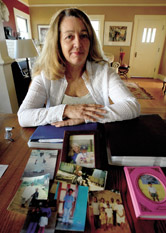
Sponsorship program supports community, children on other
continents
Glynis Crabb is the typical proud parent as she sits at her
dining room table, leafing through a photo album showing pictures
of smiling children posing with her.
What’s not typical is that the Hollister resident’s
”
children
”
live in impoverished areas half a world away
– and she’s visited most of them in their home countries.
Sponsorship program supports community, children on other continents
Glynis Crabb is the typical proud parent as she sits at her dining room table, leafing through a photo album showing pictures of smiling children posing with her.
What’s not typical is that the Hollister resident’s “children” live in impoverished areas half a world away – and she’s visited most of them in their home countries.
For a dozen years, Crabb has sponsored a total of seven children through Christian Children’s Fund, an international child development organization with a presence in 31 countries. Known for its television commercials, CCF encourages donors to sponsor a child with a monthly donation. The money is used for small business loans, to help build schools or health clinics, agricultural initiatives, even programs that shield children from illegal working conditions.
Crabb, a 60-year-old native of London, England, recalls seeing one of those commercials during Christmas years ago and being inspired to sponsor a girl from Kenya.
Since then, Crabb has sponsored children from Ethiopia, India, Ecuador and Zambia.
“I’ve heard so many people say, ‘Oh, I don’t know if my money’s going to get there and if those children really exist,'” she says. “I’ve seen them first hand and I know first hand that the children benefit and they really love their sponsors.”
Taking a study tour
Last year, in her fifth such two-week venture, Crabb traveled on a CCF study tour to Zambia to meet her 6-year-old sponsored child, Tisanke. When they met in person, Crabb offered the girl a sweater and doll, as well as a backpack and a quilt knitted in Tisanke’s favorite colors of red and green.
“After talking awhile, we started to play on the swings and slide and also with the skipping rope that I took her,” Crabb says. “The shyness disappeared and she became a typical, energetic 6 year old.”
The average monthly sponsorship is $24, Crabb says, though she sends approximately $30 on behalf of each of her sponsor children.
“The monetary amount that you send doesn’t actually go to the children,” she says. “CCF goes into an area that needs help with agriculture or schools or a medical facility and works in that area.”
Sponsors are permitted to send extra money as gifts directly to their sponsor children.
Keeping in touch
As she leafs through one of the dozens of photo albums she has chronicling the study trips she has made to visit her sponsor children, Crabb pulls out letters that the youngsters have written to her during the past two years.
“I got one from Alemayhu yesterday and Lilian a couple days ago,” she beams, showing the pictures of the children that she keeps on her refrigerator. Alemayhu is a 12-year-old Ethiopian boy and Lilian lives in Kenya.
Alemayhu wrote his letter in Amharic on a piece of notebook paper and it is translated into English on the reverse side. In it, he thanks Crabb for her birthday gift of $25, which allowed him to buy a pair of shoes, and he notes how he was recently promoted to ninth grade.
He says he has “a very good mark and am now attending (school) effectively,” adding that “winter season is being replaced by spring [and] it is getting hot and sunny.”
Crabb notes that a sponsor relations person “makes sure that children get the letters you send and make sure they write back as well.”
The letter from Lilian’s sister thanked Crabb for sending a little extra money for a sewing machine, which allowed her to open her own dress making business to help support the family.
Lilian, who has malaria, “is doing well,” according to her sister, who says the girl is healthy enough to “help her parents with some easy work like washing plates, cleaning house and fetching water from a river.”
The sponsorship, Crabb says, “raises up the family and ultimately it’s about the kids, because if you’re helping the family you’re helping the kids.”
Humble beginnings
Growing up in England, Crabb recalls “not having very much” when she was the age of the children she sponsors.
“We had a very small apartment with a sink on the landing and no running water in the apartment,” she said, drawing the connection to the children. “Most of these kids come from places where they don’t have running water.”
Crabb has come a long way since then, studying applied physics at an English technical college and later becoming an X-ray technician. She moved to California in 1975 and has lived in San Jose, Gilroy and Hollister since then. On Dec. 19, 2008, she became a United States citizen after having previously been a resident alien.
The divorced mother and grandmother now raises Welsh Cob horses at her home off Union Heights Road and sells the animals to people who use the sturdy breed for riding or pulling carriages.
Horses are a main theme of the paintings that adorn Crabb’s home. That work earned her three first place ribbons and a best-of-show award at the 2008 San Benito County Fair.
A personal connection
As she continues turning page after page in a photo album, Crabb recalls how emotional it is to meet her sponsor children for the first time, “and it’s even more emotional when you leave.”
Because of the logistics and the number of children involved, CCF sponsor day events are held in central areas where families bring their children to meet donors such as Crabb.
“We have a day where each sponsor gets to spend time with their child,” she says. “It’s really good to have that one-on-one contact.”
Those memories are burnished in photographs, such as the ones Crabb took of families making memory books in an African village.
“Because a lot of parents are dying from AIDS, the kids don’t have any record of their family history or who their parents are,” she says. “They put these books together with paper, cardboard and vegetable dye and decorate them in order to tell their story.”
Another photo showed young people selling honey and soap to raise money for an HIV support group. One picture showed a man who started a business raising pigs; yet another was of a group of women that started their own bank.
“CCF gives people seed money to start things like this to really help these communities,” Crabb says, smiling at her memories.
She has no plans to travel abroad this year, though she will continue to correspond with the children she sponsors. Instead, she will remain thankful for what she has and for her ability to help others.
“Sometimes when I’ve come back from a trip I come into my house and turn on the electricity and flip the light switch; there’s running water, there’s heat, there’s food in the refrigerator,” Crabb says. “Everything else you’ve got is just stuff.”
For more information about the Christian Children’s Fund, go to www.ChristianChidrensFund.org.









